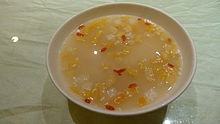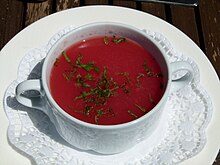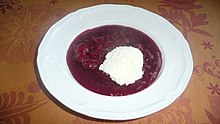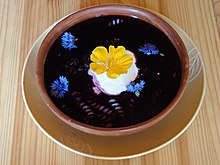Contents


Fruit soup is a soup prepared using fruit as a primary ingredient, and may be served warm or cold depending on the recipe. Some fruit soups use several varieties of fruit, and alcoholic beverages such as rum, sherry and kirsch (a fruit brandy) may be used.[1] Fruit soup is sometimes served as a dessert.[1]
Many recipes are for cold soups served when fruit is in season during warm weather.[2] Some, like Norwegian fruktsuppe, may be served warm or cold, and rely on dried fruit, such as dried prunes, apricots[3] and raisins, thus being able to be prepared in any season. Fruit soups may include milk[1] or cream, sweet or savoury dumplings, spices, or alcoholic beverages, such as sweet wine, white wine,[1] brandy or champagne.
Varieties

Avocado soup is a fruit soup that can be prepared and served as a cold or hot dish.[4][5]
Blåbärssoppa is a Swedish dish, that usually contains several kinds of berries (for example blueberries,[6] bilberries, raspberries, strawberries and/or lingonberries), sugar, water and the optional cider or, less commonly nowadays, champagne. The berries, sugar and water are boiled together to make a soup, which is then allowed to cool. When the soup is cold, cider or champagne is added, making the soup fresher and slightly carbonated.
Coconut soup is a fruit soup that can be prepared using coconut milk and coconut fruit.
Sour cherry soup is a slightly sweet soup made with sour cream, sugar and whole fresh sour cherries, and served chilled. Originating in Hungarian cuisine, this soup is a summer delicacy in several European cuisines. It may be prepared using wine[7][8] or port wine.
Starch, particularly potato starch, may be used to thicken fruit soups, to make kissel, a viscous dessert fruit dish.
By region and country

Cold and warm fruit soups are common in Baltic,[9] Eastern European,[2][10][11] Central European[10][11] and Nordic cuisines (e.g. nyponsoppa, blåbärssoppa, kissel, hideg meggyleves and krentjebrij). Hot fruit soups appear in Middle Eastern, Central Asian and Chinese cuisines. Some fruit soups in these latter regions may also be served cold, and some may be prepared using meat as an ingredient.
China
Chilled mango soup and almond-fruit soup are dishes in Chinese cuisine.[12][13] Almond-fruit soup may be served as a dessert.[13]
Europe
Consumption of cold fruit soups is a tradition in the cuisine of Eastern Europe.[2]
Nordic countries
Fruit soups are popular in Nordic countries.[14]
Fruit soups have been described as traditional in Scandinavian countries.[15] and are popular as a breakfast soup in this region during the winter.[16] Swedish fruit soup is a food staple in Scandinavian countries, and has been prepared from dried fruit during winter months.[17] Consumption of cold fruit soups is also a tradition in the cuisine of Scandinavia.[2]
Middle East
Fruit soups have been described as traditional in the Middle East.[15]
See also
References
- ^ a b c d Harris, M.R. (1993). Tropical Fruit Cookbook. Kolowalu Bks. University of Hawaii Press. p. 13. ISBN 978-0-8248-1441-0.
- ^ a b c d Sethia, A.; Agarwal, M. (2012). Healthy Cooking for Patients with Kidney Ailments. Rupa Publications India. p. 38. ISBN 978-81-291-1796-0.
- ^ Munsen, S. (2002). Cooking the Norwegian Way: Revised and Expanded to Include New Low-fat and Vegetarian Recipes. Easy Menu Ethnic Cookbooks 2nd Edition. Ebsco Publishing. p. 55. ISBN 978-0-8225-0537-2.
- ^ Sackett, L.; Pestka, J.; Gisslen, W. (2010). Professional Garde Manger: A Comprehensive Guide to Cold Food Preparation. John Wiley & Sons. p. 298. ISBN 978-0-470-17996-3.
- ^ Sandler, B. (1970). The African Cookbook. Carol Publishing Group. p. 146. ISBN 978-0-8065-1398-0.
- ^ Ohlsen, B. (2010). Stockholm Encounter. Encounter (Lonely Planet Publications (Firm))). Lonely Planet. p. 182. ISBN 978-1-74179-286-7.
- ^ De Gouy, L.P. (2012). The Soup Book: Over 800 Recipes. Dover Publications. p. 84. ISBN 978-0-486-14449-8.
- ^ Ferrary, J.; Fiszer, L. (1995). Good Day for Soup: Over 200 Recipes for Any Occasion. Chronicle Books. p. 231. ISBN 978-0-8118-0467-7.
- ^ Roufs, T.G.; Roufs, K.S. (2014). Sweet Treats around the World: An Encyclopedia of Food and Culture. ABC-CLIO. p. 33. ISBN 978-1-61069-221-2.
- ^ a b Goldstein, D.; Mintz, S.; Krondl, M.; Rath, E.; Mason, L.; Quinzio, G.; Heinzelmann, U. (2015). The Oxford Companion to Sugar and Sweets. Oxford University Press. p. 630. ISBN 978-0-19-931361-7.
- ^ a b Woods, D. (2000). Millennium Fruit Soup Cookbook. AuthorHouse. p. 1. ISBN 978-0-595-00182-8.
- ^ Foo, Susanna (2002). Susanna Foo Chinese Cuisine: The Fabulous Flavors and Innovative Recipes of North America's Finest Chinese Cook. Houghton Mifflin Harcourt. p. 329. ISBN 978-0-547-34726-4.
- ^ a b ParĂŠ, J. (2003). Chinese Cooking. Company's Coming. Company's Coming Publishing, Limited. p. 148. ISBN 978-1-896891-56-9.
- ^ Davidson, A.; Jaine, T.; Vannithone, S. (2014). The Oxford Companion to Food. Oxford Companions Series. Oxford University Press. p. 332. ISBN 978-0-19-967733-7.
- ^ a b McNair, J.K.; Brabant, P. (1990). James McNair's Soups. Chronicle Books. p. 77. ISBN 978-0-87701-753-0.
- ^ "Scandinavians, Diet of". Diet.com. Retrieved April 10, 2015.
- ^ Larsen, L. (2011). Starter Cook: A Beginner Home Cook's Guide to Basic Kitchen Skills and Techniques. Lyons Press. p. 277. ISBN 978-0-7627-7569-9.
Further reading
- Shulman, Martha Rose (October 20, 2014). "Recipes for Health: Fruit Soups". The New York Times. Retrieved April 10, 2015.
- Taylor, Coral. "Fruit Soup Recipes: Summertime in a Bowl". Mother Earth News. Retrieved April 10, 2015.

